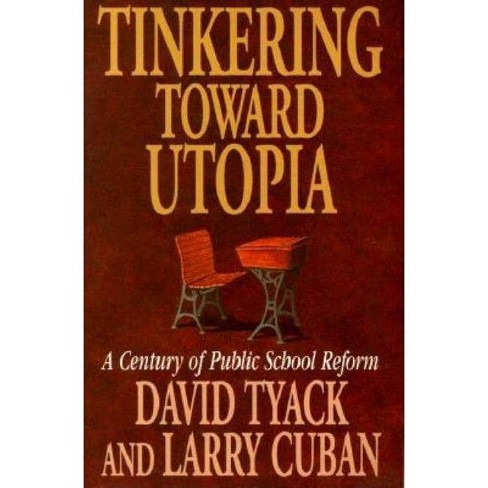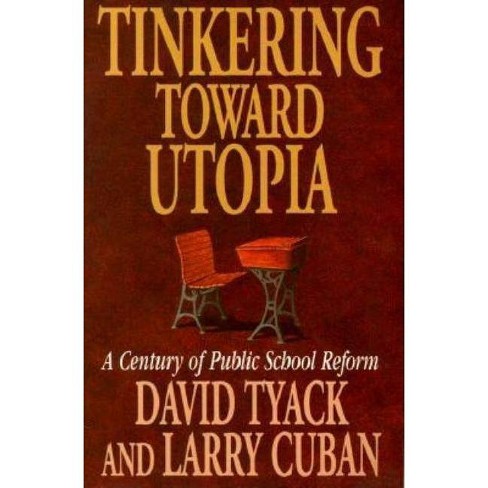It took a year of being a school reformer, tasked with making change in my profession, to turn me into an incrementalist.
The most fascinating book ever written about education, to me, is 1995’s Tinkering Toward Utopia. Written by Larry Cuban and David Tyack, two Stanford education professors, this book — from the first chapter — hell, the first page — smacked me, a would-be school “reformer,” right between the eyes.

Tyack and Cuban’s basic thesis is that American education has remained largely unchanged over the last century not because we’ve had a dearth of innovative reform initiatives — in fact, the very opposite is true, according to the book. Nor have jealous teachers’ unions, or the entrenched educational bureaucracy in general — favorite targets of foiled reformers — been the primary forces protecting the status quo (though they’ve all helped).
Instead, write the authors, the basics of American education — what they call the “grammar” of schooling — has long persisted largely because the American public knows and wants the comfort of a “real school”: age-graded, time-based, 180 days, using bells and separate subject classrooms at the high school level, awarding credits based on the Carnegie Unit, and giving grades on the 0-100 scale. Schools, the authors write, are not just innovation laboratories. They’re not businesses that must adapt to new trends or die. They’re both cultural institutions that most Americans have attended and wish to preserve and purveyors or what are often fundamentally conservative values that local and state communities wish to pass along to the next generation.
If it’s not easy to change what school looks like, write Cuban and Tyack, that’s because at a fundamental level, we want our children to attend a school that looks recognizably like the one we attended.
The authors, who long co-taught a course at Stanford on the history of American education, do what I think is the most important task historians can do: remind us of the vigorous attempts of our predecessors to tackle the very same problems we still face — and to show us why they succeeded or failed.
That’s what I learned from Tyack and Cuban: everything that seems innovative now has, in some form, been tried in the past, often repeatedly. It was fascinating, for instance, to learn that an exciting new educational program at my own school descended not only from well-documented (but hitherto unknown to me) efforts of Dennis Litky, which in themselves were heirs of the progressive tradition of both John Dewey’s Lab School in Chicago, and the famous Dalton Plan from the early 20th Century.
Want to talk about whether progressive education programs produce “college ready” graduates? Guess what — that was tried in the 1930s. It was called the Eight Year Study. Programmed instruction, along the lines of the new “personalized learning.” Sure, that was the Winnetka Plan back in the 1920s. What about the kinds of reforms that we here in Vermont are interested in — slipping away from the Carnegie Unit and from seat time requirements, allowing teachers to team-teach, giving students more freedom during the school day, and using a combination of large group, small group, and individualized instruction? Yep, those were the High Schools of Tomorrow, lavishly promoted and sponsored by the Ford Foundation . . . in the early 1960s.
That they all failed to fundamentally change the “grammar” of schooling — and that many of them, nationally famous for a time, faded from view often just as quickly as they had risen — is a truth from which Tyack and Cuban draw two conclusions.
First, the grammar of schooling has tremendous staying power, largely because of its cultural hold on Americans, but also for reasons of efficiency and practicality.
Second, though sweeping reform efforts haven’t dramatically changed the fundamentals of schools in the way reform advocates have hoped, they *have* made significant impacts on the existing system. Cuban and Tyack reminded me that so much of what we take for granted about schools were once, not that long ago, innovative reforms that quickly caught up: kindergarten, guidance counselors, even middle schools. Most of these reforms succeeded, the authors write, precisely because they sought to add to, not change, the basic age-graded, time-based school structure.
I found this all fascinating. I love learning history in a way that illuminates the present. I’m fascinated by the idea that by knowing the past you can understand the present more clearly. I love the distance that history gives us on the hot new innovative reforms of the present moment. It allows you to instantly cool down the rhetoric and see through the hype. You recognize new trends and fads for what they are because you’ve seen them before. You see through the peddlers and con men and the salesmanship and the bells and whistles and the strident advocacy. That allows you to judge any “new” idea far more rationally, with the benefit of precedent. The advantage of knowing your history is having hundreds and hundreds of actual past examples of the very same ideas having been tried out before. You just have to look back in time to see how well they worked.
It’s easy to think that a book like Tinkering Toward Utopia is cautioning any would-be reformers to temper their own enthusiasm. You might think that reading this book only served to douse the fire that made me want to try to improve education in the first place by showing me the depressingly slow rate of change in public schools. But that’s not what I took from this book.
Instead, what I learned from Tinkering Toward Utopia basically boils down to this: knowing what you’re up against and how best to fight it is the best way to change education. Don’t try to change the whole system at once; such attempts always backfire. Instead, focus on starting small; so-called “alternative” programs or academy-style “schools-within-a-school” have often been more successful than mandating sweeping changes to the entire existing program.
More importantly, spilling blood over large-scale structural or curricular changes is not only exhausting and historically doomed, but ineffective in improving the actual business of teaching and learning. Cuban in subsequent writings have described classrooms as deep sea habitats, calm and unruffled at the bottom of the ocean, while the raging storms or political and large-scale structural controversies churn the surface of the water far, far above, leaving teachers and students largely unruffled and unchanged in their daily practices far below the surface.
Instead, it is just the sort of localized, on-the-ground improvements that often only teachers themselves can make for each other which truly do improve the daily work of teaching and learning in the classroom. Effective reform efforts are therefore ones that are simultaneously more incremental and localized rather than immediate and broad.
In an important way, that’s a hard lesson to learn. You want to change the system. You want to make big, lasting improvements. You can see the problems, and you think you can see the solutions, too, so close, so easy to achieve with just the right adjustments. But you can’t do that. Quickly you realize that Tyack and Cuban are right. Making change in such a resilient, fundamentally conservative institution as a public school is incredibly hard, and making that change last beyond a few years is almost impossible. You need a certain degree of idealism to want to change, and there’s nothing particularly sexy about modest goals and incremental progress.
But that’s the way it is in education reform. That’s the way it’s been for a long time, and that’s the way it’ll always be: nothing easy, nothing simple. Compromise, incremental change, and new stuff being added around the edges. It’s a lot like democracy itself in the United States: checks and balances set up against each other to prevent sweeping changes but to facilitate slow, democratic progress. It’s the American ideal — not of perfection, but of a “more perfect union.”
That’s how our schools improve, and that’s why studying history books about schools — especially Tinkering Toward Utopia — is a smart idea.
